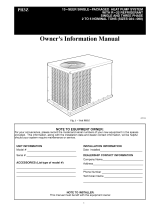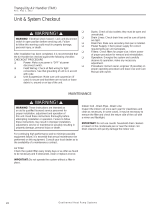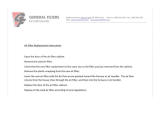
10
Grounding
WARNING:
The unit cabinet must have an uninterrupted or
unbroken electrical ground to minimize personal
injury if an electrical fault should occur. Do not
use gas piping as an electrical ground!
This unit must be electrically grounded in accordance
with local codes or, in the absence of local codes, with
the National Electrical Code (ANSI/NFPA 70) or the CSA
C22.1 Electrical Code. Use the grounding lug provided in
the control box for grounding the unit.
Control Board
The control board in the air handler controls the timing
sequence of the elements. Depending on the thermostat
connection, there are multiple timing sequence variations
that can be chosen. The board also is equipped with a 3
second blower on delay, a 15 second blower off delay in
electric mode and a 40 second blower off delay in cooling.
See Figure 11 (page 25), Figure 12 (page 25), Figure
13 (page 26), & Figure 14 (page 26) for control board
layout and Table 10, (page 21) & Table 11, (page 22)
for element sequences.
Twinning
These instructions are to be used when connecting two
B5 or B6 air handlers (2-5 ton models) to a common
single stage A/C condensing unit or heat pump. Twinning
is possible for B5 units with PSC or X-13 motors and B6
units with PSC or fixed speed (FSHE) motors. Twinning is
not possible for units with variable (VSHE) speed motors.
All low voltage wiring instructions, cautions, and warnings
accompanying the air handler remain applicable, except for:
Line & Low Voltage Connections
a. The line voltage connections for both air handlers must
be the same phase and on the same leg of power.
b. When matched with an S3BM or an S3BW series AC
outdoor unit, both air handler’s 24V transformers must
be removed from the control circuit by removing and
discarding the RED wire located on the transformer’s
secondary. These outdoor units come standard with 24V
power supply sufficient for powering both air handlers.
c. Low voltage wiring should be connected as shown in
Figure 10 (page 24).
d. Wire all other low voltage thermostat terminals to both
air handlers as shown in Figure 9 (page 24).
IMPORTANT: Variable speed air handlers cannot be
twinned. Please follow the instructions supplied with
the kit.
Heater Kits
Field-installed electric heater kits are available. Instructions
for installing the electric heaters are included with the
heaters. Additional heater kit information can be found in
the units Technical Specifications.
Air handlers set up with 15 kw or more of electric heat will
normally be configured for multiple-circuit power supply.
They may, however, be connected to a single-circuit power
supply with the addition of a single circuit accessory
kit. Select the wire size and over-current protection
in accordance with the minimum circuit ampacity and
maximum over-current protection shown in Table 9, (page
20). See also the units Technical Specifications.
When electric heat packages with circuit breakers are
field-installed, the circuit breaker may be used as a
disconnecting means in most applications. Reference
the NEC and local codes for disconnect requirements.
If a heater kit is installed:
The MB7 air handler is shipped from the factory without
an electric heater kit installed. If Electric heat is desired,
the H8HK heater kit may be purchased separately and
field installed. Determine the correct size heater kit for your
unit by referring to the list below or the units rating label.
A Size Cabinet (800 CFM) ............................. 10Kw max
A Size Cabinet (1200 CFM) ........................... 15Kw max
B Size Cabinet ............................................... 20Kw max
C Size Cabinet ............................................... 20Kw max
1. Connect the 2 wire plug of the air handler to the mating
2 wire plug of the heater kit.
2. Connect the line voltage leads to the circuit breaker or
terminal block provided.
3. Connect the heater kit plug with the mating receptacle
on the air handler control board.
If a heater kit is not installed:
1. Remove the 2 wire plug of the air handler by cutting the
wires and discarding the plug.
2. Strip the ends of the 2 air handler wires and connect
to the line-voltage leads with the 2 wire nuts provided.
Humidifier
The unit has an output to power a humidifier when the
blower is running. This output is rated to 1.0 amp at
208/240V. Connection is made to the HUM terminal on
the motor control board. See Figure 13 (page 26).
Dehumidification Options
(MB7EM or MB7VM Models Only)
Both motor control boards (Figure 13 & Figure 14) have a
DHUM connection that allows the system to increase the
amount of humidity that is removed from the circulating air.
This is accomplished by reducing the CFM and allowing
the cooling coil to become colder. This will only occur when
there is a call for cooling. There are many ways that this
can be electrically wired.
1. If the room thermostat incorporates a humidity sensor and
DHUM output, connect the DHUM on the thermostat to
the D terminal on the motor control board. See
Figure 6
(page 11).
2. If using a separate humidistat, connect the DHUM & R
terminals on the humidistat to the D & R terminals on
the motor control board of the air handler. In this option,
the DHUM output of the humidistat must be set so it is
only closed when there is a call for dehumidification.
3. If a humidistat is not available, it is an acceptable option
to connect the R & D terminals on the motor control board






















